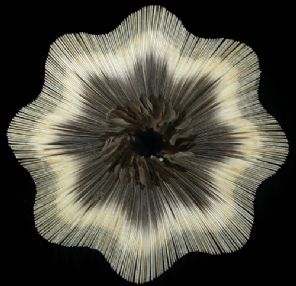Nathanael, “Baby” hasn’t adjusted to the furniture change in the family room. He still sleeps in the same spot even though the sofa he liked to sleep under was moved.
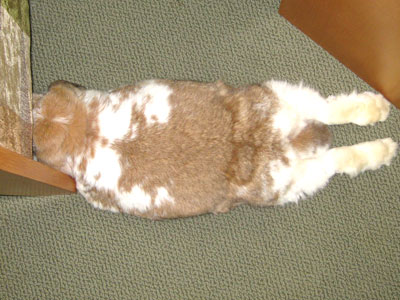

Nathanael, “Baby” hasn’t adjusted to the furniture change in the family room. He still sleeps in the same spot even though the sofa he liked to sleep under was moved.


I suspected that at some point, I would create the perfect environment for some type of insect. When you have loads of dried plant materials and fiber it is rather likely some critters will move in.
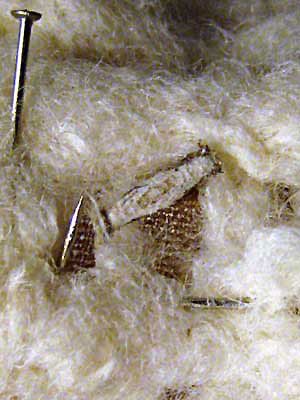
This is a detail of a work in progress. It would have been a cup made of wool and rayon that I just couldn’t manage to finish. The head of a straight pin is in the upper left of the photo, and the tip of a pin is next to the casemaking moth.
How Did I Find Moths?
I read an article that stated empty birds’ nests should be removed from around your house because casemaking moths might take up residence. I had a collection of nests containing little vignettes in my studio. When I checked them, I found casemaking moths. After the shock wore off, and the sinking feeling that everything in my studio might be destroyed; I methodically started the hunt for the critters. I discarded materials and several works in progress.
I did a test to see if I can save a piece if it is found to have moths. I soaked some works in progress that had been attacked by moths in vinegar for a couple of days, rinsed in water, and laid them in the sun. My hope is that if there were eggs, they were killed.
The vinegar soaking changed the appearance of the pieces. I bind fiber onto washers for use as coding components. The bottom row was soaked in vinegar. The washers are not the same type, but they have a similar composition. The fiber is wool that sustained a color change due to the oxidation of the metal. The change in color of the cream wool is not to my liking, so the solution would be to age the washers, then bind them.

If the same or similar result occurs the next time I use a vinegar bath, I’m pretty sure that I will use the technique in the future to age some pieces. It is simple and non-toxic.
I found the casemaker moths–
Some insects are attracted to a particular color, fragrance or pheromone, or a location. I did not find a pattern or consistency in where they made their homes.
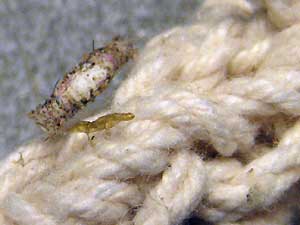
And it does not seem to matter if the fiber was impregnated with wax or shellac. It may be too early to tell, but I do not think that they took up residence in or on any of my work that was treated with salt.
This is the edge of a piece of foam core that I used for a photo set-up.
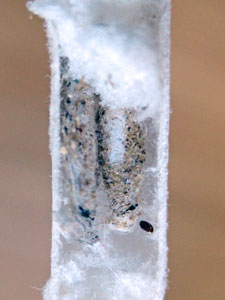
For More Information From Reliable Sources–
Casemaking Clothes Moth AgriLife Extension Texas A&M
Clothes Moths by Mike Potter, Extension Entomologist, University of Kentucky, College of Agriculture
Clothes Moths University of California Agriculture & Natural Resources, Statewide Integrated Pest Management Program
A couple of days ago I subscribed to the Netflix DVD service specifically because I wanted to see the series, Game of Thrones. When I checked my DVD queue next to the first disc was the dreaded word–Wait. I was disappointed.
Yesterday I received an email that stated the first disc of Game of Thrones would arrive today.
And it did!
I had forgotten how much I love receiving those red envelopes.
I have been using the Netflix streaming service since I gained access to an iPad. The instant gratification of streaming is great, but I missed having access to information about films, directors, screenwriters, and actors that comes with the DVD subscription. I enjoy viewing the body of work by a particular person, or films with a similar theme.
Game of Thrones was on my list because I wanted to see more of Peter Dinklage after viewing The Station Agent.
The other thing that bothered me about having only the streaming service after having both streaming and DVD, was the loss of my DVD queue. Whenever I read about a film that sounded interesting I would add it to my queue. Often those titles appeared in the Saved section.
I did find my queue by accident–
After I signed in to my account I went to the Netflix blog and clicked on the RSS Feed Page.
On the RSS Feeds under Personalized Feeds I clicked on Queue and there was my DVD queue.
I made a copy of it.
Time for popcorn and Game of Thrones.
I received my first real comment on one of my blog posts from Dinah at Discardia.
Yesterday I spent the better part of the day cleaning my studio space because of the moth scare. I decided to clear out the truly unneccesary “potential” art materials. Throughout the day I kept asking myself, “What would Dinah do?” At the end of the day, there was her comment.
Serendipitous.
Uncertainty about my choices faded; I felt validated.
I did have a weak moment, one in which I felt a bit overwhelmed with the task at hand. To calm my mind I typically do one of two things–read or bake. I opted for baking chocolate chocolate-chip cupcakes with chocolate frosting.
Vegan of course.
The recipes are based on Jennifer McCann’s book, Vegan Lunch Box–Triple Chocolate Cupcakes and Chocolate Vegan Buttercream.
After a cupcake I went back to my studio refreshed and ready for the task. I needed to stop addressing the cleaning and clearing in a random, willy nilly way. I needed to be methodical.
I started with the first set of shelves where loads of small open containers of bits are stored. Interesting that the boxes of jars that I was keeping for someday came in handy.
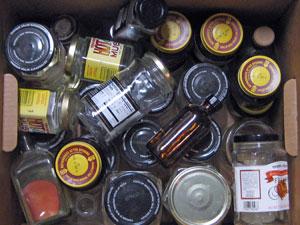
Yeah, I am pretty sure that I am not going to make snow globes.
And lids will keep out unwanted critters.
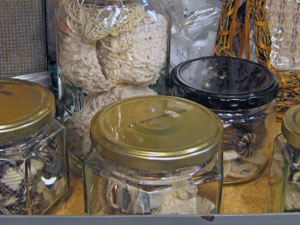
Nathanael “Big Baby” and “Queen” Nora appreciated your comments too.
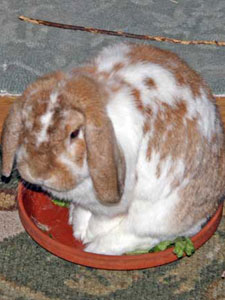
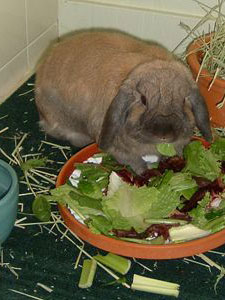
The past weekend I found some fiber looking somethings near the baseboard in the family room. On closer inspection and after a google search I found out the terrible news. They are Tinea pellionella, casemaking moths.
They are known as casemaking moths because according to the Statewide Integrated Pest Management site of University of California Agriculture and Natural Resources, “…always carry a silken case with them as they feed. They never leave this silken tube, but enlarge it as they grow.” Apparently the case is supposed to be the color of the fabric they have eaten. Most of the critters I found on the gray-green wool carpet are rather tan.
So here is the thing, if they stay in their silken vessel and it grows with them, and they are rather small when I find them, two questions come to mind.
How long have I not seen them?
And how many are there that I can not yet see?
Totally creeps me out.
Apparently, the female can lay “an average of 40 to 50 eggs…” but I was unable to find out how many of those eggs will be viable.
Most of the information I found indicated that pyrethrin was the solution. I do not want to use dangerous chemicals. We share our home with house rabbits who frequent the space. Any chemical residue could end up on their fur which could be potentially dangerous when they groom themselves or each other. Actually if there are fumes, respiratory problems could occur as well.
I emailed my friend at the UC Botanical Garden to find out how to handle the situation. After talking with him, I pretty much decided that I would give the carpets a good cleaning and then probably try an application of Diatomaceous earth. Unless I opt for the new information that I found tonight on the Northwest Center for Alternatives to Pesticides site. The article stated that while cold temperatures are not effective, placing a space heater at 120º for 4 hours in the room where the moths have been found can be.
Then the horror of horrors occurred to me. I had read that it is a good idea to remove all bird nests near your house. The moths find nests a great place to thrive. I got a sick feeling when I realized I have nests in my studio. What if the moths have gotten in my studio? I have several pieces in progress, hung, and stored in the space; many have a fiber element. I started on one wall and made my way around the space. And it was confirmed that they really do like nests and even some of the work in progress had been attacked.
This is the interior of a lid that has protea seeds bound to hardware cloth.
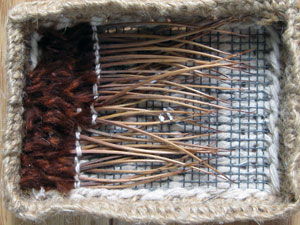
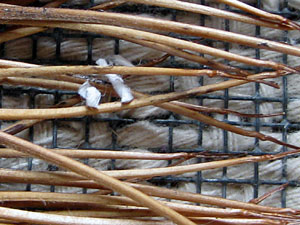
Some work that is constructed of bound plant material and coated with wax had evidence of moths. There was one bronze and ceramic piece that had a single critter attached to its underside.
I disposed of most of the work. It was amazingly invigorating throwing out stuff. Then I found a ceramic cup bound with wool that had an application of shellac. I placed the piece in a container of vinegar.
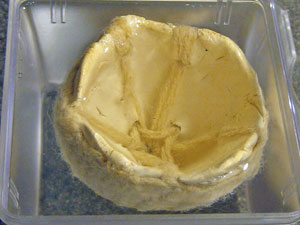
I also had bound some split washers for a code piece and noticed there were a couple of critters in the container so I dumped the lot in vinegar. There is a single floating critter.
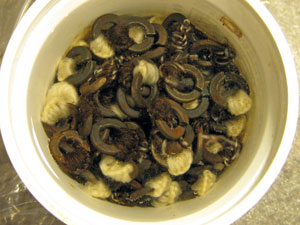
What I do not understand is why they did not attack the larger wool pieces that are in progress, but they did attach themselves to one of my clean work shirts hanging next to them. I’m glad it was the shirt.
Tomorrow I need to do a thorough cleaning of my studio.
I am in the the process of making my life a bit lighter. So I tackled three shelves in my clothes closet. Do I really need tee shirts from the 80s and 90s?
I gave my neice the cool shirt that changes color with your body heat and those gift shirts that I never wore.
While I was going through the stacks of shirts, I found a great gray cardigan that had googly eyes for buttons. Since I didn’t have a set of buttons to replace the googly eyes, I grabbed some stainless steel washers and wool and made some Dorset-like buttons.
I started by using a wrap and knot technique. With every wrap, the needle was taken through the loop made during the wrap process.
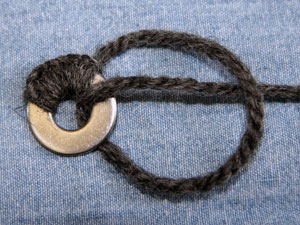
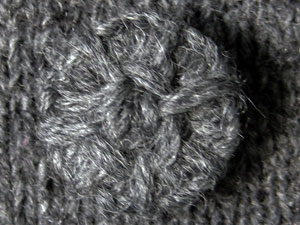
I felt that the result was a bit fussy for the cardigan so I wrapped a washer with wool and bound it to another washer. Then the lot was stitched to the sweater.
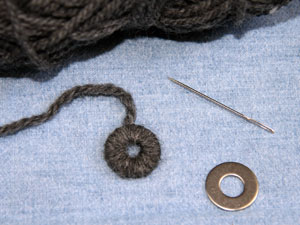

The bulkier button seemed a better fit with the style of the cardigan.
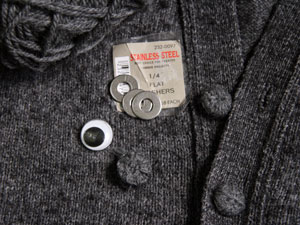
I am a mixed media artist and have a habit of gathering and keeping “things” because I might need them “sometime.” I tell myself that most of my “stuff” was accumulated as potential art materials. And eventually I do use a lot of the materials or offer them for use by other folks.
Recently I happened on Discardia and found some great advice on how to possibly clean up my life. For me starting small and working a bit at a time is much better than trying to do everything at once. The completion of small jobs will offer me a sense of accomplishment rather than failing to complete everything now. I plan to set a time limit to prevent becoming annoyed that the task is taking time from enjoyable activities.
My first task was to give away recently received gifts that I didn’t want or need. They are perfectly nice gifts for someone else. Check that one off of the list.
Then I read the post, Letting go of our back pages which addresses the issue of too many books. While I was attempting to be rid of some of my books that I had not manage to read for whatever reason, I found myself reading one. Now I am half way through and thinking that I might pick up the next book in the trilogy.
Maybe clearing out the computer books will be an easier task.

I remember seeing a television program about the Wieliczka Salt Mine on PBS, TLC, or the History Channel. So, when I received an email with images of the mine I was delighted.

Then a very cool thing happened. The attached link took me to the UNESCO World Heritage site which has loads of amazing information and images of places of cultural importance categorized by country.
I plan to spend some time on the site in the near future.
Early on in my education at Ohio State University, I became aware of artists who would go to a site and use the materials present on that site to make a work. Often the work appeared as though it occurred naturally.
I had a romantic notion of visiting the woods near my parents’ home, connect with the site, and make a work. When I attempted it, I realized right off that I wasn’t alone. There were snakes, mosquitos, and ticks, all of which creeped me out.
I recently read about Stuart Wood’s environmental work on the Studio ‘g’ blog. The images of his scorched patterns on trees gave me pause. I like the idea of using a scorching process to alter a material. And that controlling a potentially destructive process can result in something beautiful.
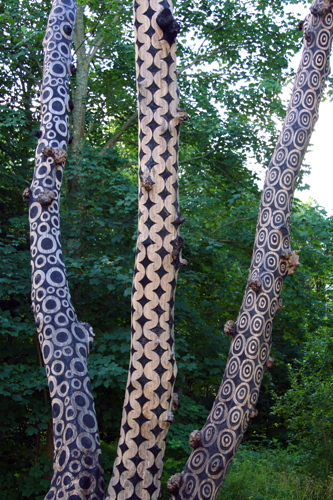
When I visited Stuart Wood’s website I found many gorgeous pieces. And I admit that I found myself saying out loud, “…really, seagull feathers.”
